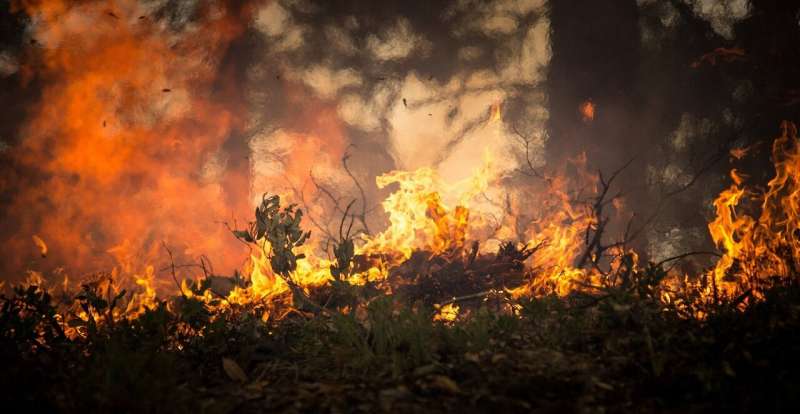Credit: CC0 Public Domain
Research co-led by the Center for Research on Desertification (CIDE, CSIC-UV-GVA) describes the mechanisms that make major forest fires possible. Climate emerges as one of the main triggers by fostering the flammability of the fuel, along with drought conditions and the effectiveness of ignitions.
An article published recently in Frontiers in Ecology and the Environment, from the Ecological Society of America, establishes the ingredients and mechanisms required for there to be major forest fires. Four ingredients are required: ignition, fuel, drought and appropriate meteorological conditions. The study establishes a model that shows how these four ingredients are connected and upholds that climate change increases the ideal conditions for major forest fires. The work is co-led by the Center for Research on Desertification (CIDE), mixed center of the Spanish National Research Council (CSIC), the University of Valencia (UV) and the regional Valencian government.
The study suggests a model that describes how major forest fires are created. This model establishes that major fires take place when three thresholds are breached simultaneously: ignitions, the availability of fuel and drought. According to the study, these three thresholds decrease and are breached more easily with certain meteorological conditions, such as dry winds (for example, westerly winds in the Valencian Community) and high temperatures (favored by climate change).
Once these three thresholds are breached, fires are created which can be of a large scale (megafires), generating their own dynamics (so-called 'fire storms'), and surpassing the fire-extinguishing capabilities of fire fighters. "These conditions have taken place at times in the Valencian Community, and they will likely be amplified in coming years as climate change advances," says Juli G. Pausas, researcher at the CIDE of the CSIC and co-author of the study together with Jon Keeley, from the Geological Department of the United States.
Meteorological conditions emerge as the triggering factor to create fires in a specific ecosystem, as they decrease the thresholds of the other three ingredients. According to this study, climate change materialized as drought and high temperatures makes it possible for less ignitions and less fuel to be required to cause major forest fires. The fact that an increasing number of tropical hurricanes are arriving at the coasts of the Iberian peninsula, favoring the spreading of fires, is in the same line.
"It is important to take into account that an ignition and favorable meteorological conditions for fires are not enough to cause major fires; extensive and flammable biomass is also required," explains the CIDE researcher. The availability of this 'fuel' is affected by the topography, the type of vegetation, its structure and the human use of mountain terrain, among other factors. "Certain continuity of the fuel is needed to generate major fires, and in the Valencian Community, as well as in the entire Mediterranean basin, this continuity is mainly created by the rural exodus and a decrease in agriculture and grazing," says Pausas.
Managing the factors that trigger major fires
Thus, climate change does not only affect the behavior of the fire (making them more intense), but also has an effect on increasing the size and duration of the fire, as well as the time window during which major fires can occur. Among the conclusions drawn from the study which can be useful to manage the factors that trigger these major fires, the authors suggest that avoiding just one of these essential factors to start a major fire (ignitions, drought or fuel continuity) could significatively decrease the likelihood of forest fires from taking place.
"It is important to decrease ignitions in areas where the wind has a leading role in generating major fires. Meanwhile, generating fuel discontinuities, so-called mosaics, is more relevant in ecosystems where drought is key for fires," says Pausas. Researchers suggest, when modifying these factors is not possible, to designate fire hazard areas where human activity is decreased as much as possible, as is done now in areas near active volcanoes or in areas that are prone to floods.
More information: Juli G Pausas et al, Wildfires and global change, Frontiers in Ecology and the Environment (2021). DOI: 10.1002/fee.2359
Journal information: Frontiers in Ecology and the Environment
Provided by Asociacion RUVID
























